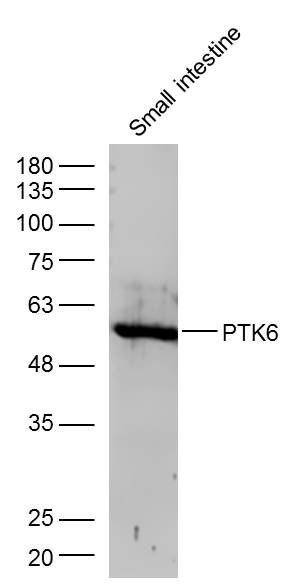產品貨號 : mlR6266
英文名稱 : PTK6
中文名稱 : 酪氨酸蛋白激酶6/乳腺腫瘤激酶抗體
別 名 : Breast tumor kinase; Breast tumour kinase; Protein tyrosine kinase 6; PTK6; Tyrosine protein kinase BRK; PTK6_HUMAN.
研究領域 : 腫瘤 信號轉導 激酶和磷酸酶
抗體來源 : Rabbit
克隆類型 : Polyclonal
交叉反應 : Human, Mouse, Rat, Cow, Sheep,
產品應用 : WB=1:500-2000 ELISA=1:500-1000 IHC-P=1:400-800 IHC-F=1:400-800 IF=1:100-500 (石蠟切片需做抗原修復)
not yet tested in other applications.
optimal dilutions/concentrations should be determined by the end user.
分 子 量 : 52 kDa
細胞定位 : 細胞核 細胞漿 細胞膜
性 狀 : Lyophilized or Liquid
濃 度 : 1mg/ml
免 疫 原 : KLH conjugated synthetic peptide derived from human Brk/PTK6:201-300/451
亞 型 : IgG
純化方法 : affinity purified by Protein A
儲 存 液 : 0.01M TBS(pH7.4) with 1% BSA, 0.03% Proclin300 and 50% Glycerol.
保存條件 : Store at -20 °C for one year. Avoid repeated freeze/thaw cycles. The lyophilized antibody is stable at room temperature for at least one month and for greater than a year when kept at -20°C. When reconstituted in sterile pH 7.4 0.01M PBS or diluent of antibody the antibody is stable for at least two weeks at 2-4 °C.
PubMed : PubMed
產品介紹 : This protein encoded is a cytoplasmic nonreceptor protein kinase which may function as an intracellular signal transducer in epithelial tissues. Overexpression of this gene in mammary epithelial cells leads to sensitization of the cells to epidermal growth factor and results in a partially transformed phenotype. Expression of this gene has been detected at low levels in some breast tumors but not in normal breast tissue. Its presence in the nucleus appears to be linked to suppression of tumor progression. The encoded protein has been shown to undergo autophosphorylation.
Function:
Non-receptor tyrosine-protein kinase implicated in the regulation of a variety of signaling pathways that control the differentiation and maintenance of normal epithelia, as well as tumor growth. Function seems to be context dependent and differ depending on cell type, as well as its intracellular localization. A number of potential nuclear and cytoplasmic substrates have been identified. These include the RNA-binding proteins: KHDRBS1/SAM68, KHDRBS2/SLM1, KHDRBS3/SLM2 and SFPQ/PSF; transcription factors: STAT3 and STAT5A/B and a variety of signaling molecules: ARHGAP35/p190RhoGAP, PXN/paxillin, BTK/ATK, STAP2/BKS. Associates also with a variety of proteins that are likely upstream of PTK6 in various signaling pathways, or for which PTK6 may play an adapter-like role. These proteins include ADAM15, EGFR, ERBB2, ERBB3 and IRS4. In normal or non-tumorigenic tissues, PTK6 promotes cellular differentiation and apoptosis. In tumors PTK6 contributes to cancer progression by sensitizing cells to mitogenic signals and enhancing proliferation, anchorage-independent survival and migration/invasion. Association with EGFR, ERBB2, ERBB3 may contribute to mammary tumor development and growth through enhancement of EGF-induced signaling via BTK/AKT and PI3 kinase. Contributes to migration and proliferation by contributing to EGF-mediated phosphorylation of ARHGAP35/p190RhoGAP, which promotes association with RASA1/p120RasGAP, inactivating RhoA while activating RAS. EGF stimulation resulted in phosphorylation of PNX/Paxillin by PTK6 and activation of RAC1 via CRK/CrKII, thereby promoting migration and invasion. PTK6 activates STAT3 and STAT5B to promote proliferation. Nuclear PTK6 may be important for regulating growth in normal epithelia, while cytoplasmic PTK6 might activate oncogenic signaling pathways.
Isoform 2 inhibits PTK6 phosphorylation and PTK6 association with other tyrosine-phosphorylated proteins.
Subunit:
Interacts with GAP-A.p65. Interacts (via SH3 and SH2 domains) with KHDRBS1. Interacts (via SH3 and SH2 domains) with phosphorylated IRS4. Interacts with ADAM15. Interacts (via SH3 domain) with SFPQ. Interacts with EGFR and ERBB2. Interacts with STAP2. Interacts with PNX. Interacts with SFPQ. Interacts with PTK/ATK. Interacts with CTNNB1.
Subcellular Location:
Cytoplasm. Nucleus. Cell projection, ruffle. Membrane (By similarity). Note=Colocalizes with KHDRBS1, KHDRBS2 or KHDRBS3, within the nucleus. Nuclear localization in epithelial cells of normal prostate but cytoplasmic localization in cancer prostate.
Tissue Specificity:
Epithelia-specific. Very high level in colon and high levels in small intestine and prostate, and low levels in some fetal tissues. Not expressed in breast or ovarian tissue but expressed in high pourcentage of breast and ovarian cancers. Also overexpressed in some metastatic melanomas, lymphomas, colon cancers, squamous cell carcinomas and prostate cancers. Also found in melanocytes. Not expressed in heart, brain, placenta, lung, liver, skeletal muscle, kidney and pancreas. Isoform 2 is present in prostate epithelial cell lines derived from normal prostate and prostate adenocarcinomas, as well as in a variety of cell lines.
Post-translational modifications:
Autophosphorylated. Autophosphorylation of Tyr-342 leads to an increase of kinase activity. Tyr-447 binds to the SH2 domain when phosphorylated and negatively regulates kinase activity.
Similarity:
Belongs to the protein kinase superfamily. Tyr protein kinase family. BRK/PTK6/SIK subfamily.
Contains 1 protein kinase domain.
Contains 1 SH2 domain.
Contains 1 SH3 domain.
SWISS:
Q13882
Gene ID:
5753
Important Note:
This product as supplied is intended for research use only, not for use in human, therapeutic or diagnostic applications.
產品圖片












